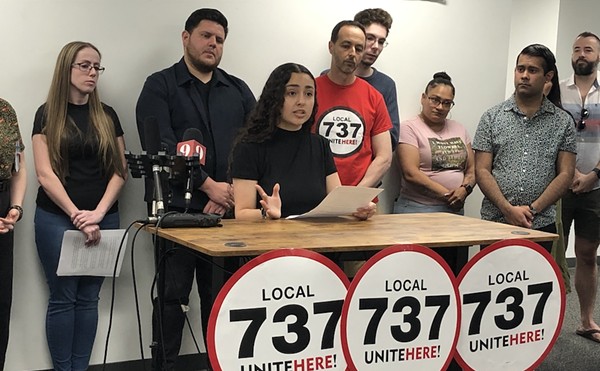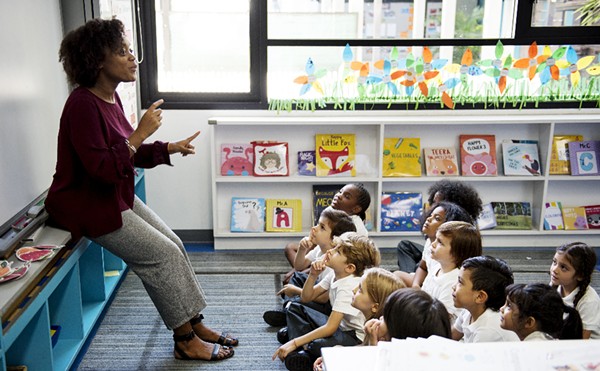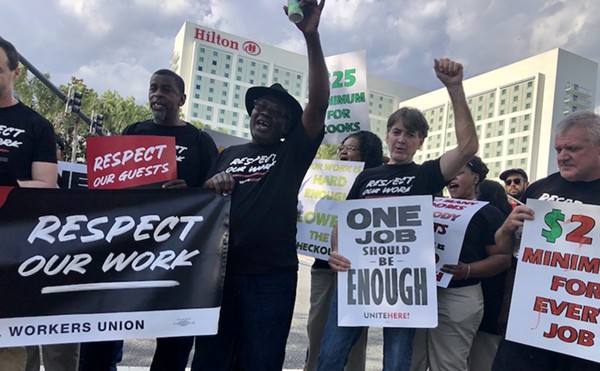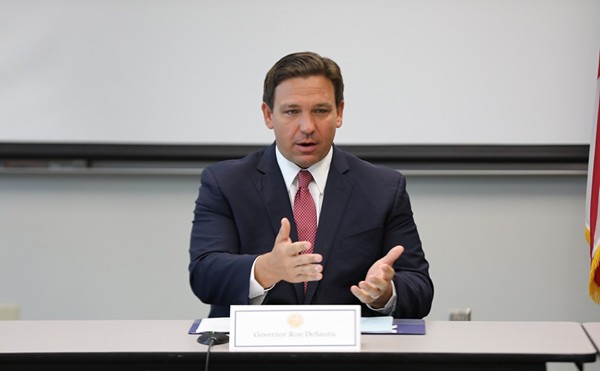"This is an institution," Sarah Jane Turner says. "But it doesn't have to look like an institution."
Indeed, much effort has gone into making Great Oaks Village, an Orange County group home that houses as many as 84 abused or neglected children, appear as normal as possible. The seven cottages that house the children, ages 6 to 19, resemble college dorm rooms. The walls are adorned with pictures of other, smiling children. There are no signs or gates that announce the home's presence.
"Most people will never see Great Oaks Village from Michigan (Street)," says Turner, Great Oaks' senior program manager. "That's how we want it."
"They're not on display," adds Lee Ann Lowery, manager of Orange County's youth and family services division.
Great Oaks is the oldest and largest group home in Orange County, and one of the largest in the southeast United States. Last year, the home celebrated its 80th birthday, though it hardly resembles the facility created in 1924, then known as the Orange County Parental Home. Today, Great Oaks serves as a backstop for kids – mostly teens – with nowhere else to go. The majority of children here have been either sexually or physically abused, or been the victims of severe neglect. In most cases, the state Department of Children and Families was unable to find suitable relatives or foster homes for the kids. Some will stay for months; others for years.
None of them are easy cases. "These kids don't come to us all happy and well adjusted," says Lowery. "They have an expectation of failure. They have been betrayed by every adult they ever trusted. When they come here they're angry or withdrawn. They're depressed. Educationally, they're behind, and expect to be behind."
The mission is simple: Take kids from broken homes, get them up to speed with their peers in school, get them interested in sports, art or some other extracurricular activity, send the ones who are able to college, and prepare the rest for productive lives in the real world. Ultimately, the hope is that they won't repeat the mistakes their parents made.
In a state where bad headlines besiege the often inept and underfunded DCF, and in a region with a significant shortfall of foster homes – Orange County has only about half the number it needs – Great Oaks Village has managed to keep itself off the front page of the newspaper and out of the 6 o'clock news. That is, as Orange County Mayor Rich Crotty notes, an achievement in and of itself. Great Oaks is an example of something that Orange County does right, even down to providing an adequate budget to keep it going.
Orange County made a commitment to Great Oaks, long before the state got involved in the business of caring for kids with nowhere else to go. Today, the county still funds about $2.6 million of Great Oaks' $4.2 million budget. A contract between Great Oaks and the Department of Children and Families pays the rest. On average, housing a child costs Great Oaks Village $68 per day.
Unlike other group homes in the area, Orange County still calls the shots.
"There has always been a lack of resources [in the state's foster care system]," says Lowery. "We were doing Great Oaks Village before the state took over. The state contract is extra money."
There's no ideological agenda at play – just helping troubled, hurting kids get back on their feet.
"One of the things that's very strong, we have a corporate culture within the county, a commitment to families," Crotty says. "It's a very strong commitment. What impresses me most about Great Oaks Village, it's not just the level of commitment, it's the time of commitment. This is something the county took on as a core value. Our community has changed, but that does not minimize our commitment to provide a stable environment for these young people."
ON CAMPUS
My first visit to Great Oaks Village is on an overcast Tuesday morning. There are no kids on campus now; they're all at school. Turner first walks me through a cottage for residents 16 and older – the "independent living" facilities. It's the only coed housing at Great Oaks, and it's designed to "make a more normal life," before the kids go off to college.
Ten teens live in this dorm, though it has room for 12. Kids 18 and up get private rooms. Those younger share a bedroom. There are two televisions in the common living room: one for watching, one for playing Xbox, which came as a Christmas gift from local corporate donors, Turner says. The kids make wish lists every year, and donors do what they can to see that the lists are fulfilled. Luxuries that are beyond the means of Great Oaks tend to get purchased this way.
All kids at Great Oaks get an allowance. High schoolers get $10 a week; middle schoolers $5; and elementary-age kids between $1.50 and $3.75. Older kids are allowed to hold part-time jobs if they keep their grades up. Great Oaks mandates that they put at least 75 percent of their income into a savings account, which they can use after they leave to get started on their own; as a down payment on a car, for example, or a security deposit on an apartment.
But school comes before work, says Turner, a former high-school principal. "I don't believe in them working. Their job is school."
The cottage for younger high-school girls has three beds to a room, and each living space is generously adorned with stickers. SpongeBob SquarePants is a favorite. "They drive me nuts with those stickers," Turner says.
In the center of Great Oaks Village sits a 19th-century mansion called the Hagood House. The Hagood family donated the house to Great Oaks Village in 1971. A year later, it was cut in half, moved from the family's property in the Lake Conway area to its current location and refurbished. It reopened as part of Great Oaks Village in October 1973. Today, it houses a library of donated books, an art room and administrative offices upstairs. Downstairs is a private living room for older kids. The foyer is where Great Oaks kids meet their dates for the prom or homecoming.
A field next to the Hagood House serves as a play area – and sometimes Pop Warner football field – and there's a basketball court under a pavilion in the back of the campus. Younger kids have a playground next to the elementary cottage.
Directly across from the county's health and family services administrative offices, located closer to the road on the Great Oaks campus, is the county's 18-bed Youth Shelter, which houses an assortment of runaways and troubled adolescents, some of whom were ordered there by a judge. Unlike the kids at Great Oaks, these kids go to school on-site, in a building that once served as a schoolhouse for all of Great Oaks' kids until the 1960s.
The most striking thing about Great Oaks is probably the palpable sense of commitment to the kids on the part of staffers. They see themselves as parents, and in many cases, the kids see them the same way.
"They may leave, but this is still home," Turner says. "We're still mommy and daddy."
THE WHIP COMES DOWN
In 1900, several Orlando boys were caught stealing; country archives aren't clear on what they stole or from whom, but history does recount that the case was big news at the time. At the turn of the century, there was no juvenile justice system to speak of. But Orlando lawman Marshall Charley "Slewfoot" Carter didn't think it was a good idea to lock them up with adults. So Carter came up with a different punishment: He had the boys tied to vinegar barrels and "lashed with a heavy strap" 25 times.
Carter and his supporters dubbed the whippings a success, because the boys were not caught stealing again. But juvenile crime didn't go away. In fact, it worsened. Parents of the era linked the increasing problem to the fact that city teachers were banned from using corporal punishment. The parents exerted pressure on the Orange County commission, which in turn lobbied the state Legislature to create a juvenile justice system.
By 1911, the state was beginning to form its juvenile justice and child welfare systems, and ordered county judges to supervise delinquent or dependent children. By 1915, the state authorized counties to create separate juvenile detention centers with "literacy and industrial school training."
In 1919, Donald A. Cheney, a 30-year-old probation officer and graduate of Rollins and Dartmouth colleges, became convinced that Orange County needed its own institution to handle juvenile cases. In 1921, at Cheney's prodding, the Legislature agreed, and the governor appointed him as the county's first juvenile court judge. He was paid $600 a year, and served two four-year terms.
Under his watch, the Orange County Parental Home opened in December 1924, on land that had been the county's "poor farm" since 1888. Cheney appointed a Board of Visitors, a volunteer group, to help oversee the home. For the first 10 years the city and county co-funded the home; later, the city bailed on chipping in its portion.
In 1927, the county built a schoolhouse on the grounds. Classes ended at the eighth grade. Boys were taught "manual arts," and girls were taught "domestic arts." The home was run like a farm. The children had school in the morning and did chores in the afternoon. A few cows and chickens provided milk and eggs, and fruits and vegetables were grown on the grounds. The local prison farm produced beef and pork for the home.
In 1945, a state law specifically gave the county commission, not the juvenile judge, control of the home.
From its opening until 1973, Great Oaks Village served as a home for homeless and destitute children, as well as for delinquent children. It had a "youth hall" that was essentially a juvenile detention center and courthouse. In 1974, a state law placed juvenile justice under the auspices of the state, instead of the county. Orange County responded by leasing its "youth hall," which housed delinquents, for $1 a year to the state until 1990, when the county built a separate juvenile courthouse. The Youth Shelter sits where that building once stood.
Statistics kept by the county track the number of dependent children at Great Oaks versus the number of delinquent children. In 1940, 411 dependent and 387 delinquent children came and went. By 1948 – after World War II, when men came home and many women stopped working – there were 123 dependent and 279 delinquent children. The first black child was admitted to Great Oaks Village in 1970.
GUARDED CONDITION
Because of state privacy laws, it's not easy to talk to Great Oaks residents. Eventually, however, I was able to interview two teenage boys, both of whom were wards of the state after a judge terminated their parents' rights. The boys were allowed to speak only under the supervision of Great Oaks staff, and with the stipulation that their real names not be used and no photos of them taken. The circumstances that led to the termination of their parents' rights were out of bounds for discussion.
P.J. Guerriero, the county health and family services department's community relations manager, describes one of the boys – let's call him James – as "one of our best students; he's also a very strong tennis player."
In fact, James is supposed to be skipping his tennis practice to talk to me. In typical teenager fashion, he's late: He forgot and went to practice anyway. Great Oaks dispatches a van to pick him up.
James is soft-spoken and a little shy. He's 15, a sophomore at Boone High School, and has lived at Great Oaks for three years. "I didn't want to be here," he says, when I ask him about his feelings about going to Great Oaks. "It was kind of intimidating, all the people, the [lack of] privacy and stuff. At first I didn't really care. I was kind of depressed because I wanted to be home and stuff."
James' daily routine is relatively mundane. He wakes up at 5:30 a.m., cleans his room, watches TV and heads for school by 7:10 a.m. If he doesn't have tennis practice – a sport he took up after arriving at Great Oaks – he does his homework after school, then wanders around looking for something to do. Some nights, James goes to dinner in the cafeteria. Other nights, he makes something in his cottage.
I ask him about changes he's seen in himself since coming here. "I'm more involved in people and activities and stuff than I used to be," he says. "After I got over being depressed, I got used to [being at Great Oaks] and started making friends and stuff. I'm kind of lucky. I've had my own room for six months. Before that, it was kind of crazy because I hated people touching my stuff."
In school, James is pulling a 3.8 grade point average. Great Oaks is trying to line him up with sponsors to pay for a summer trip to a leadership conference in Boston.
James says he's adjusting. "I'm learning to deal with the different types of people." While some of his friends know where he lives – which hasn't affected his social life too much – it's not something he advertises. "No, I wouldn't invite them here," he says.
Andrew – again, not his real name – is 17, and in the six months since he's been at Great Oaks, he has become fast friends with James. When he arrived, there was a sense of being lost. "I got dropped off, and told this is where I'm going to be. I was like, 'OK, where am I?'" he says.
But he embraced his surroundings, even though at first he was the only white kid in his cottage, which was another cause for unease. "I like it," he says now. "I can stay here and not have to pay taxes or anything. And I get free room and board. I don't have to pay electricity and water."
Hearing a 17-year-old's relief at being free of the pressures of adulthood speaks to the type of background many of the Great Oaks kids come from. Per my agreement with Great Oaks, however, I couldn't press him for details on his past life.
Andrew is a sophomore, and he'll turn 18 at the end of the year. At that point he'll have the option of leaving, or he can stay until the day before his 20th birthday, which is as long as county law allows.
I ask him what's different about him now that he lives here. "I go to school every day," he says. "That's different."
For Christmas, Andrew got an Xbox, two controllers, and two copies of Halo 2, thanks to Great Oaks' benefactors. "I was happy," he says with a smile.
For Lowery, Great Oaks' biggest success is the eight former residents currently enrolled in college or vocational schools. Three more of its students will graduate in June and go to college, she notes. And there are other success stories, which Great Oaks staffers happily rattle off: One of their Boone students – who was four years behind in his school work when he came to Great Oaks – was the school's Martin Luther King Jr. Humanitarian of the Year award winner. An elementary student was named a Disney Dreamer and Doer in the Disney-sponsored program that rewards students in Central Florida for confidence and curiosity.
ONE OF A KIND
Great Oaks Village works, in large part, because it's adequately funded. In the early 1970s, when it subsisted on county money but needed to expand, it entered a contract with the state's Health and Rehabilitation Services department, predecessor to the Department of Children and Families. Even when the state stepped in, the county's commitment didn't wane.
The program has also resisted the state's push for privatization. In the last two years, the state began contracting with private companies to handle its foster care system. Florida Services of Metro Orlando handles foster care in Orange and Osceola counties. Unlike the 20 or so group homes that FSMO deals with, however, Great Oaks Village is the only one that continues to contract directly with the state instead. Larry Jones, the director of Orange County's Health and Family Services department, says contracting with the state directly ensures a dedicated funding source. After all, Jones notes, Great Oaks has fixed costs – it has to be able to take in up to 84 kids, 365 days a year.
Greg Kurth, FSMO's executive vice president, says he wants to rely less on group homes. He does so now because there's a dearth of foster care: Orange County has 225 foster homes, but needs twice that number. Osceola County has 60, but needs at least 180, Kurth says. "We've actually made a lot of progress in the last year in terms of recruiting foster parents."
FSMO contracts with about 20 homes throughout the region, and places children based on who has the space and ability to take them in. Almost all of the centers are nonprofit. Some take in as few as six kids at a time, and some are connected to either churches or national nonprofit groups. FSMO coordinates all area referrals, including those to Great Oaks.
In Osceola County, that county's only group home has come under scrutiny because it is "crumbling," according to an Orlando Sentinel story. Commissioners worried that since there is no state funding for a new building, rebuilding the home amounts to an unfunded mandate. The facility could be closed.
But Orange County still believes in the value of group homes, including Great Oaks Village. Great Oaks staffers say that many children – especially adolescents who aren't looking for a new father and mother – fare better in a group home than with new foster parents. In fact, they say, many of the kids who end up at Great Oaks have gone through several foster homes without success. Even Kurth admits that group homes like Great Oaks are often stopgaps that "break the cycle" of kids bouncing from home to home.
"We have a saying that these kids are our kids," Crotty says. "That has really grown to be a core value in Orange County government."



















